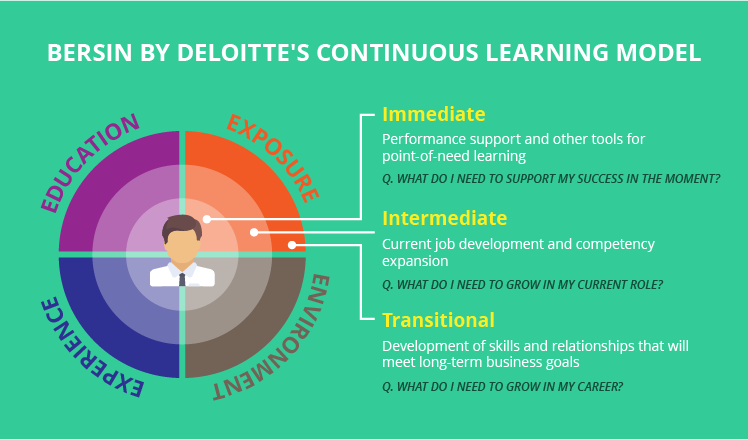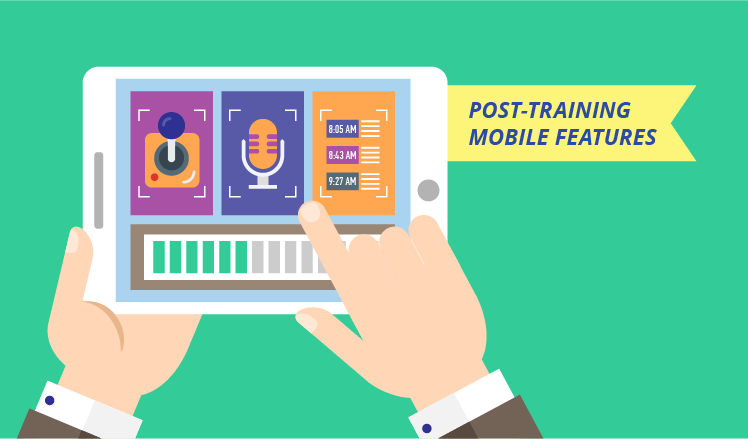Corporate training has come a long way, from personal development and tutored workshops to eLearning portals and mobile learning apps. Nevertheless, the process of gaining new knowledge is only a quarter of the Continuous Learning Model, coined by Deloitte. Skill development and long-term goal orientation is what can foster employees’ potential to its fullest and lead to feasible results.
Focusing on mobile technologies and referring to the latest research in corporate learning, this article uncovers what is yet to be done in terms of skill building and competency expansion, as well as suggests mobile solutions to address the challenge of reconstructing and solidifying practical experience and behavioral pattern.
The perks of the industry worth $9.1 billion
Chunked, affordable and more personalized, mLearning captivated today’s overwhelmed and constantly distracted learner. Statistically, 29% of U.S. organizations, whose HRM strategy includes the use of mobile learning software, report higher engagement rates than those without it. Ambient Insight Mobile Learning Market Forecast predicted the mLearning industry to reach $9.1 bn.
Mobile learning paves the way to flexibility and more manageable career growth. With an entire training material database at hand, employees can control their development on their own by selecting the learning module for any skill they want to obtain. Moreover, taking the shape of bite-sized interactive flashcard quizzes, mobile training sessions follow the spaced repetition method that, according to a Rutgers University research in neuroscience, ensures long-term knowledge retention.
But knowledge acquisition is just one quarter of the Continuous Learning process. Mobile technology can be beneficial for all the components.
What is the Continuous Learning Model?
Josh Bersin, the founder of Deloitte, designed the circular Continuous Learning Model that consists of 4 Es: Education, Exposure, Environment and Experience. Education is the 25% covered by common corporate training, while Experience is a natural and uncontrollable development that advances with time. Being the first and the last stages respectively, these 2 Es are almost useless without the other two – Exposure and Environment, which are most difficult to ensure.

Exposure starts when an employee gets down to their immediate duties in practice. The smoother and more satisfying the adjustment, the more motivation this employee has to pursue further professional growth. The development levels to be covered by Exposure are ‘immediate’ (point-of-need training) and ‘intermediate’ (competency expansion).
Environment is about career growth on a bigger scale: the skills that should be fostered on this stage aren’t necessarily applicable to a current job position. For instance, employees can develop their leadership skills in advance and back themselves up for the promotion to the management level in the future. At this stage, the transitional level of learning (long-term business orientation) should be covered.
The implications of leaving Exposure and Experience out of the scope
Pressured by the necessity to perform uncommon tasks, employees are prone to stress, anxiety, and, in case of insufficient training, even panic. These negative feelings can elicit unprofessional behavioral patterns: a person who learned how to structure and moderate a presentation can unconsciously pick up a habit of speaking hastily and indistinctly. Unable to succeed in the presenter’s role, they won’t even see a reason to learn transitional skills.
In another scenario, skills gained at trainings but not put to use right away can go rusty with time, and the efforts both the employee and the company have put into trainings will eventually be wasted.
This is exactly why the post-training phase is important and should be a part of HRM. Provided that employees can easily recall theory from the Education stage and confidently put it into practice during Exposure, they will be open to new knowledge useful for their company’s business Environment. The balanced process of performing assigned tasks and learning new skills for further development is what will create an employee’s professional Experience.
‘Post-training’ mobile features
Mobile apps can help employees brush up their practical skills and avoid dysfunctional behavioral patterns in order not to diminish the success of their newly obtained skills. The suggested features below are customizable for any industry and can become effective post-training tools, whether as the foundation for one-feature apps or if combined.

Virtual simulators
All simulators are supposed to help employees recreate situations they will most likely find themselves in at work, and can be used for both immediate and transitional levels of training. For some jobs, simulating can be easy: those who learn to work with website content can simply try out the corporate CMS before they are assigned content management tasks. However, not all skills are tied to using software and can’t be easily ‘tried out’.
A virtual simulator can substitute specific tools and appliances that, for example, should be installed on the customer’s premises. An app that lets an employee virtually connect all cords and cables of any company’s device will quickly ensure mastering of the product installation skill.
Audio simulators
When a skill implies a certain behavior or attitude, its simulation seems even more challenging. Yet, an unfortunate presenter from one of the previous sections can record parts of the presentation to train the liveness, emotionality, loudness or distinctness of speech. Apart from simply listening to the recording, the employee can receive objective feedback from the app that will analyze the audio pitch according to the characteristics marked as ‘to improve’ beforehand.
With an app that stores multiple audio templates of a real-life dialogue with a customer, a services company employee can practice their customer-facing behavior. By tweaking the ‘emotion’ settings, they can train to deal with impatient, indifferent or annoyed clients and get prepared for all occasions.
Interactive behavior logs
If an employee already has a dysfunctional habit, they might need special training tools to reshape their behavior. In his book, The Power of Habit, Charles Duhigg shares how psychological methods of replacing one habit with another can help in generating healthy patterns in the working behavior. The essence of the method is to notice a habitual action every time it occurs, take a note of it (literally), understand the reason or stimuli that caused it, and try to consciously behave in the opposite way.
Supporting interactive logs, a mobile app will not only engage an employee in making entries on their dysfunctional behavior cases, but also suggest counter-actions. For instance, an employee responsible for correspondence with the company’s biggest clients can have a habit of postponing replies to negative e-mails. The log feature will teach them to acknowledge the habit and replace it with replying to unsatisfied clients in the very first place.
Keeping an eye on skill progress
All the skills that employees have up their sleeves comprise their personal competency profile. The profile naturally changes over time, and if a company has over 500 employees keeping a close eye on all of them is impossible even with the best HRM systems. However, a mobile feature that would allow employees track their most important competencies would let them feel more responsible for their own growth.
The app, displaying a competency profile in a manner of a game character’s skill list, will build a vision of what an employee is capable of, how good they are at it exactly, and what they lack in order to progress to the next stage. Thus, it covers the intermediate and transitional training levels. Moreover, having an additional testing feature (or synchronized with the company’s existing HRM testing module), the app can regularly ensure the skill quality and update the profile according to the latest results.
Conclusion
For corporate learning efforts not to be in vain, theoretical training should always be followed by practice and skill adoption. Mobile app development companies can enhance effectivity with mobile post-training solutions that allow employees simulate work with tools and appliances, rehearse conversations with troublesome clients, get rid of the habits that are in the way of the career growth as well as be in a complete control of personal chances to get a swift promotion.

Looking for experienced mobile app developers who can create your app from scratch or get into gear on an existing project? You've just found them.
